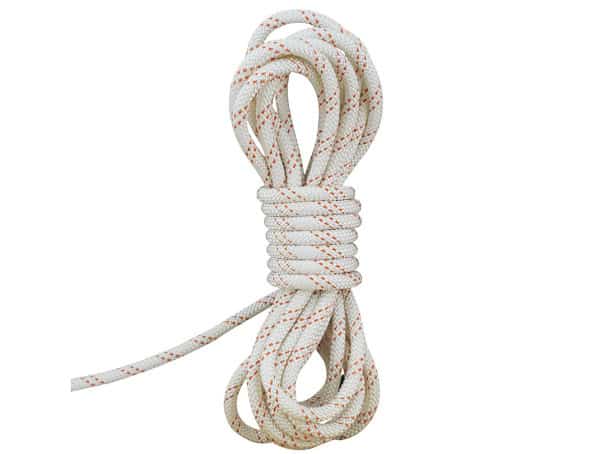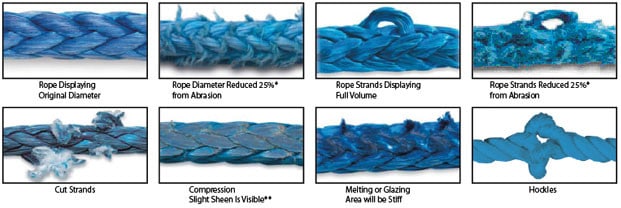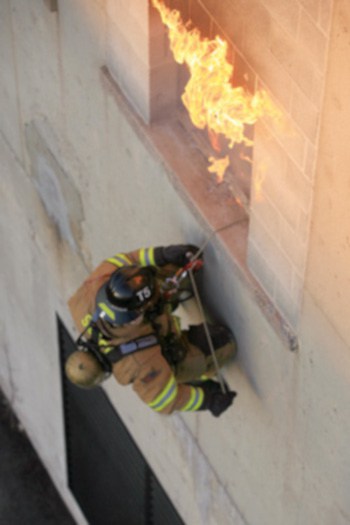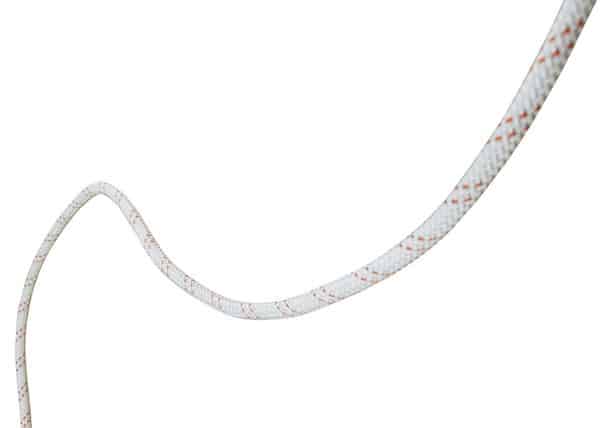Life safety rope service life and NFPA requirements for inspection
Life safety ropes are regularly exposed to conditions that could lead to dangerous damage and put firefighter’s lives at risk. Proper inspection and record-keeping are essential to determine if the rope is still safe for use during rappelling or rescue operations.
In our previous post, we discussed NFPA requirements for cleaning and storing rope—procedures which extend a life safety rope’s service life. In this blog, we explore how to inspect life safety rope and keep an accurate history to determine whether it can remain in service or must be retired.
If education isn’t the reason for your visit today, view our online selection of rope.
Factors that shorten the service life
Life safety rope can be severely damaged and fail when cut by a sharp edge or subjected to abrasion over rough surfaces. Repeated exposures to flame or otherwise high temperatures can cause degradation over time that leads to failure during use. Damage also occurs from high stresses, impact-loading situations, kinking, and exposure to chemicals and various products.
To ensure rope performs reliably, the 2018 edition of NFPA 1858: Standard on Selection, Care, and Maintenance of Life Safety Rope and Equipment for Emergency Services establishes inspection requirements for life safety rope compliant with the 2017 edition of NFPA 1983: Standard for Life Safety Rope and Equipment for Emergency Services. Following the manufacturer’s specific instructions is also essential.
While NFPA 1858 (A.10.1.2) points to 10 years as the typical retirement age for life safety rope, it also emphasizes that the rope’s history and the amount and type of use can significantly shorten its lifespan (A.6.1.8.1). Regardless of the stated service life, the condition of the rope as determined by a qualified inspector is critical to determining whether it is still fit for life safety operations.
NFPA 1858 mandates that life safety rope must be inspected by a “competent equipment inspector.” The authority having jurisdiction (AHJ) defines who is “competent” which is typically determined by the professional training and standards executed by fire departments and rescue personnel.
From the 2018 edition of NFPA 1858
6.1.1 The AHJ shall specify minimum requirements for training and experience necessary for a person to be a competent equipment inspector.
6.1.2 The AHJ shall develop guidance for equipment inspection, based on Chapter 6, industry best practice, manufacturer’s instructions, and other relevant information.
Life safety rope must be inspected before it is put in service and before and after every use. Ropes that become soiled or contaminated during use must be properly cleaned before inspection. The exact procedures are developed by the AHJ but based on the manufacturer’s instructions, standard professional best practices, and universal life safety precautions:
6.1.3 Manufacturer’s instructions shall be followed for all inspection, care, and maintenance.
6.1.4 Universal precautions shall be observed, as appropriate, in the handling of life safety rope and equipment that was exposed to contamination during use.
6.1.5* Any life safety rope and equipment that is found to be soiled or contaminated shall be cleaned or decontaminated before any additional inspection is initiated. If decontamination is not possible or warranted, contaminated life safety rope and equipment shall be retired.
6.1.6 The organization shall establish guidelines for its members to follow in determining if an element is soiled to an extent that cleaning is necessary.
6.1.7 The organization shall determine appropriate actions to be taken if life safety rope and equipment is found to be in need of cleaning, decontamination, or repair.
6.1.7.1 At a minimum, any necessary cleaning or decontamination shall be done in accordance with the requirements specified in Chapter 7.
6.1.7.2 At a minimum, any necessary repairs shall be made in accordance with the requirements specified in Chapter 8.
6.1.8* Age of equipment shall be taken into consideration as part of the inspection process.

How to perform an inspection
NFPA 1858 also requires “periodic” thorough inspections that depend on how often the rope is used: for instance, if life safety rope is deployed weekly, weekly inspections are appropriate; if it’s deployed a few times a month, monthly inspections are adequate (A.6.2.1.3 (1)). Inspectors are responsible for logging the results after every inspection.
From the 2018 edition of NFPA 1858
6.2 Inspection Procedures.
6.2.1* Life safety rope and equipment shall be inspected periodically according to the organization’s policy for inspecting life safety rope and equipment.
NFPA 1858 (A.6.2.5.1) asserts that the decision to retire a life safety rope or keep it in service relies on “good judgment that comes from experience in working with rope.” Proper inspection procedures require organizations to develop policies and shelf-life criteria for their equipment that’s based on the manufacturer’s instructions (A.6.2.1), as well as the conditions and environments encountered within the fire department’s operations (NFPA 1983: A.5.1.1.8). Inspections include visually inspecting a rope, feeling for damage, and checking its history in the rope log.
Inspectors must visually scour the sheath for signs of damage, including cuts, chafed areas, glazed surfaces, discolorations, dirt, or mildew. Carefully look for unusual or uneven wear on the rope, especially watching for areas where the core is exposed or enough of the sheath is worn that its ability to protect the core is compromised.

Tactile inspections should be performed with tension on the rope. Hold the rope firmly in one hand and pull it between your thumb and index finger about 18 inches at a time while feeling for broken fibers, soft or hard spots, and variations in diameter that could indicate damage to the core or that the rope has been overstressed. Do not wear gloves, which would impact your ability to perform a thorough inspection. Signs of chemical contamination aren’t always visible, so pay attention to strong or odd odors that could indicate a problem.
NFPA 1858 classifies inspections into “predeployment,” “routine,” and “thorough” categories, outlining specific steps for each type:
6.2.1.1 Predeployment Inspection. Prior to making the item available for service, the user shall perform a predeployment inspection as follows:
(1) A visual check shall be performed in a manner sufficient to ensure that all the components are present and none of them are compromised.
(2) Where the equipment is assigned to an individual, the predeployment inspection shall be performed prior to a duty shift.
(3) Where the equipment is not assigned to an individual, the AHJ shall determine the appropriate interval.
(4) Any deficient components shall be removed from service and subjected to a thorough inspection.
6.2.1.2 Routine Inspection. The user shall perform a routine inspection before and after each use as follows:
(1) Routine inspection shall be performed in a manner sufficient to ensure that the product is safe for use.
(2) Routine inspection shall include, at a minimum, visual and tactile inspection for mildew, wear, damage, and other deterioration.
(3) Any deficient components shall be removed from service and subjected to a thorough inspection.
6.2.1.3 Thorough Inspection. The organization shall determine at what intervals a thorough inspection is needed as follows:
(1)* Thorough inspections shall be scheduled based on use of the equipment.
(2) Thorough inspections shall be performed at least once each year and shall include a more in-depth evaluation of equipment condition, including visual and tactile, and information including, but not limited to, age, date of purchase, and usage log review.
(3) This inspection shall be documented.
6.2.2 Life safety rope and equipment shall be inspected by an inspector meeting the organization’s requirements for the type of inspection conducted of life safety rope and equipment.
6.2.4 Each user shall be trained to conduct a predeployment and routine inspection.
6.2.5 Inspection shall include, as a minimum, the inspections specified in 6.2.5.1 through 6.2.5.15. [see below]
When to retire a life safety rope
If any of the below imperfections are found, NFPA 1858 (8.2) mandates that organizations immediately remove the rope from service and destroy it, or reserve it for non-life-safety purposes:
6.2.5.1* Life safety rope shall be retired from service if inspection reveals damage resulting in a performance deficiency due to the following:
(1) Soiling
(2) Contamination
(3) Physical damage, including but not limited to the following:
(a) Cuts, chaffing, broken fibers, or soft or hard spots on the sheath
(b) Thermal or chemical damage that can be detected by sight, feel, or smell, such as melted fibers, glazed surfaces, or discoloration
(c)Any variation in the rope diameter
(4) A history in the rope log of shock load, fall load, static load, or excessive loading
(5) Excessive age
NFPA 1983 (A.5.1.1.8) defines destruction of life safety rope as making sure it’s “altered in such a manner that it could not mistakenly be used as a life safety rope. This could include disposal or removal of the label and cutting the rope into short lengths to be used for utility purposes.” Most manufacturers recommend destroying the rope once it is retired so there is no chance of it being accidentally used for life safety operations.
Life safety rope should also be taken out of service if the log indicates that it has been subject to shock load, or a sudden or drastic increase in load, fall arrests, or any abuse other than normal rappel or rescue use (NFPA 1858 A.6.2.5.1). Additional factors that impact the decision to retire a rope include its age and its exposure to weather, sunlight, and unknown environmental chemicals during use or storage (A.10.1.2). Every manufacturer offers specific instructions for proper inspection of life safety rope and detailed explanations about when it should be retired.
It’s worth noting that most manufacturers will provide service for equipment items that are repairable. However, repairing the rope typically costs more than replacing it—and any repairs attempted without the manufacturer void the warranty and release the manufacturer from liability or responsibility.

Service records save lives
Accurate histories are critical to ensuring the viability of life safety rope—and most manufacturers recommend retiring it if full histories can’t be determined. NFPA 1858 requires fire departments to maintain records for every life safety rope in their service, from date of purchase to date of retirement.
Logs should include training evolutions, actual incidents, and inspections. They should inventory the date the rope was used, the location, the type of use, any exposure, the dates of cleaning and inspection, and the name of each inspector.
Most important, the log should record any unusual circumstances that occurred during use, such as damage, shock loads, or use over sharp edges. Remember that people’s lives can depend on knowing this information, so take pains to record the rope’s history as accurately as possible. It’s also important to double-check that the rope matches the log you are using to record the information.
From the 2018 edition of NFPA 1858
4.3.1 The organization shall compile and maintain records on its life safety rope and equipment.
4.3.2* At least the following records shall be kept for each life safety rope and equipment item:
(1) Equipment identification
(2) Date of purchase
(3) Date placed in service
(4) Manufacturer and model number
(5) Month and year of manufacture
(6) Dates of use, including how used, weather conditions, potential damage, and other circumstances relating to use
(7) Dates of cleaning and inspection
(8) Removal from service and date of return
6.2.3 The date of the inspection and the results of the inspection shall be recorded in the appropriate log or on a tag attached to the life safety rope and equipment for that purpose.
Deploying life safety rope with confidence
People’s lives depend on the consistent performance of life safety rope. Meeting NFPA inspection and record-keeping requirements are critical to ensuring that it works safely during rappelling or rescue operations.
If you’re looking to buy life safety rope, browse QRFS’ selection of Bulwark Safety X Rope that’s NFPA-approved for rescue operations.
To learn more before purchase, check out our previous blog that introduces the Bulwark Safety X, one of a handful of technical-use life safety ropes to receive Underwriters Laboratories’ (UL) stamp of approval.
We also carry Night Saver Rope, a glow-in-the-dark rope popular for marine uses, firefighting search lines, camping, and much more.
For questions or help placing an order, call us at +1 (888) 361-6662 or email support@qrfs.com.
This blog was originally posted at blog.qrfs.com. Check us out at Facebook.com/QuickResponseFireSupply or on Twitter @QuickResponseFS.




Hi, can somebody share with me, what is the best practice to test our life safety rope before we conduct rappelling / descending activities. And one more thing, is there any written instruction to perform a test during acceptance of a new life safety rope, if yes, what kind of test it is.
Thank you
Yaacob
Yaacob — Broadly speaking, all testing and maintenance requirements for life safety rope are in NFPA 1858: Standard on Selection, Care, and Maintenance of Life Safety Rope and Equipment for Emergency Services and NFPA 1983: Standard for Life Safety Rope and Equipment for Emergency Services. A manufacturer will also list tolerances, specs, and instructions. As far as “acceptance testing,” we’re unaware of any that a user must do before using new rope, but we could have one of our pros dig into the standards to verify. If you buy NEW, appropriately rated and listed rope that meets the requirements for the specific job (rappelling) from a reputable manufacturer, it will perform to the tolerances specified. Ropes can degrade over time and use, however, so the NFPA standards have maintenance and retirement guidelines in those cases.
Hi,
I know we are supposed to keep records of all life safety rope and equipment but what if it hasn’t been done? The agency I’m working with doesn’t have rope logs or equipment logs. I’m attempting to keep this equipment in service by x-raying the equipment to look for any hairline fractures to remove is from service. I have inspected the life safety rope and identified the NFPA 1983 strand inside the tail of the 1ft section I removed. The life safety rope is with in 10 years of manufacturer date and has passed all visual and hand inspections. I intend to create rope logs and create equipment logs for the equipment they have after inspection and after gathering all the information I can about the equipment. Will this suffice or do I need to remove it all from service?
Thanks in advance!
Bo — First, we are glad that you are now on top of this maintenance, record-keeping, and replacement. Unfortunately, we can’t provide a definitive answer, as we are not AHJs and the rules in NFPA 1858 also defer heavily to a specific “organization’s policy for inspecting life safety rope and equipment” and manufacturer instructions. Since your organization seems to lack a clear policy, we’d advise that you contact other, similar agencies to inform a policy and the rope manufacturers to get more definitive guidance. Otherwise, the inspection conditions and item in NFPA 1858 are a good guide, including sections 6.2.1 – 6.2.5. And you, of course, can’t go wrong with simply replacing any old rope. Best of luck and thanks for reading!
Good day all,
I have just come across rope that was manufactured in 2010 (Still New on spool, never touched).
Also it has been kept in an environmentally controlled atmoshere.
So the question I have if this still usable in the Emergency Rappel Service?
Gary — Unfortunately, we cannot provide you with a definitive answer. However, ASTM F1740 may have more info, and here is the full section from the Annex of NFPA 1858 (2018 edition):